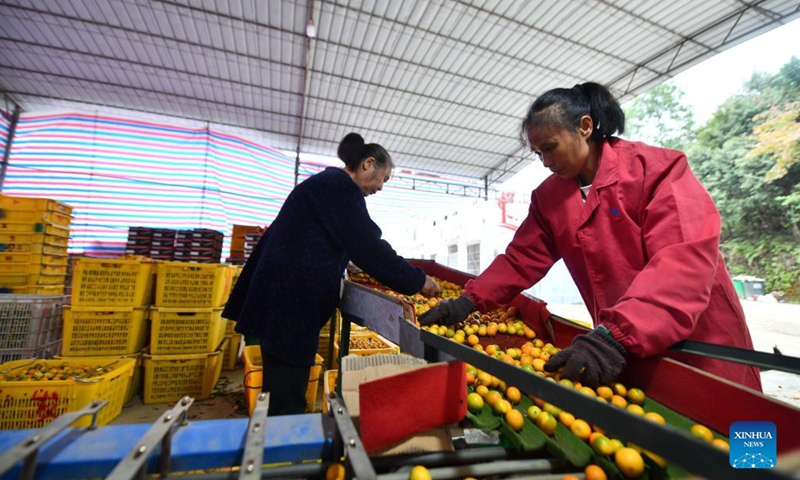
Villagers sort kumquat fruits in Banmao Village of Dajiang Town in Rongan County, south China's Guangxi Zhuang Autonomous Region, Nov. 19, 2021. Over 200,000 mu (about 13,333 hectares) of kumquat trees have recently entered harvest season in Rongan County. Over the last few years, authorities have promoted the kumquat planting business, which has become a pillar industry in increasing the income of local farmers. (Xinhua/Huang Xiaobang)
As local authorities in Dongxing, South China's Guangxi Zhuang Autonomous Region, a major hub for fruit imports from Southeast Asian countries such as Vietnam and Thailand, imposed strict epidemic prevention and control measures, fruit traders are diversifying their sources to curb potential disruptions.
Operations at Dongxing port has remained suspended since December 21, the Global Times learned. The situation has led to unprecedented challenges for fruit traders, who are turning toward domestic suppliers in preparation for the Chinese New Year in late January.
Moreover, industry insiders told the Global Times on Tuesday that they are facing losses of up to hundreds of thousands of yuan after containers of fruit from Vietnam and Thailand couldn't be cleared.
"There are a lot of goods on hand that have not yet gone out, and the loss is huge… as far as I know, there are still over 2,000 containers of fruit trapped in Vietnam and Thailand after the border port closure," Chen Peihui, a manager with Guangxi Hesheng Customs Broker, told the Global Times on Tuesday.
In line with anti-epidemic requirements, there are restrictions on imports, exports and vehicles, especially at the ports, a staff member at the Dongxing port customs told the Global Times on Tuesday.
The person said that the situation in the region is still severe, and customs clearance will resume only after the port is notified by local anti-epidemic authorities.
"Many local merchants have reported cargo backlogs in the WeChat group organized by the local government, and hope that the government can speed up customs clearance and simplify procedures once the border service resumes," Chen said.
A customer service worker at a Taobao fruit store told the Global Times on Tuesday that inventories are adequate for Vietnamese dragon fruits, which can be stored at low temperatures for up to a month.
Several areas in China, including parts of East China's Zhejiang Province and North China's Shanxi Province, have reported positive test results from dragon fruits imported from Vietnam, prompting emergency measures, including the closure of some local supermarkets and wholesale markets, according to media reports.
China is Vietnam's largest export market. In the first 11 months of 2021, Vietnam's exports to China exceeded $50.16 billion, a year-on-year increase of 16.1 percent. Fruit and vegetable exports to China stood at $1.8 billion, accounting for about 55 percent of the total exports of fruits and vegetables, according to statistics from Vietnam Customs.
The domestic producing regions for dragon fruits are mostly concentrated in South China's Hainan, Guangdong and Guangxi, but the production capacity can't always meet domestic demand, which is why there's a growing need for imports every year, industry insiders said.
Coupled with potential concerns of shortages and booming demand ahead of the Chinese New Year, the prices of imported fruits, including dragon fruits, have increased.
In the past, Vietnam's dragon fruits were cheap, but now they're considered too expensive, a Beijing-based customer said.
A manager with a local trade company in Dongxing surnamed Huang said that fruit prices overall may rise further as inventories for some imported fruits run out and demand rebounds ahead of the Chinese New Year in January.
Instead of waiting for the border to reopen, the company is diversifying its sources, including from domestic suppliers in Southern China that grow similar fruits that are ready for harvest, according to the manager.
"A lot of fruits are grown in China. They're cheap and plentiful, but it still takes time for domestic customers to change their preferences from imported ones," Huang said.




